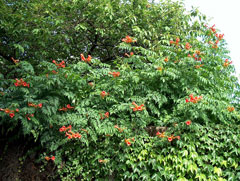 |
|
http://commons.wikimedia.org/wiki/User:Stan_Shebs |
 |
| http://commons.wikimedia.org/wiki/User:Annelis |
Translate this page:
Summary
Bloom Color: Orange, Yellow.
Main Bloom Time: Early summer, Late summer, Mid summer.Form: Spreading or horizontal, Variable height, Variable spread.
Physical Characteristics

 Campsis radicans is a deciduous Climber growing to 12 m (39ft 4in) at a fast rate.
Campsis radicans is a deciduous Climber growing to 12 m (39ft 4in) at a fast rate.
See above for USDA hardiness. It is hardy to UK zone 4. It is in leaf from June to October, in flower from August to September. The species is hermaphrodite (has both male and female organs).
Suitable for: light (sandy), medium (loamy) and heavy (clay) soils. Suitable pH: mildly acid, neutral and basic (mildly alkaline) soils. It cannot grow in the shade. It prefers moist soil.
UK Hardiness Map
US Hardiness Map
Synonyms
Bignonia radicans. Tecoma radicans. (L.)Juss.
Plant Habitats
Woodland Garden Sunny Edge; Dappled Shade; Ground Cover; South Wall. By. West Wall. By.
Edible Uses
References More on Edible Uses
Medicinal Uses
Plants For A Future can not take any responsibility for any adverse effects from the use of plants. Always seek advice from a professional before using a plant medicinally.
Diaphoretic Vulnerary
The root is diaphoretic and vulnerary[61, 218].
References More on Medicinal Uses
The Bookshop: Edible Plant Books
Our Latest books on Perennial Plants For Food Forests and Permaculture Gardens in paperback or digital formats.

Edible Tropical Plants
Food Forest Plants for Hotter Conditions: 250+ Plants For Tropical Food Forests & Permaculture Gardens.
More

Edible Temperate Plants
Plants for Your Food Forest: 500 Plants for Temperate Food Forests & Permaculture Gardens.
More

More Books
PFAF have eight books available in paperback and digital formats. Browse the shop for more information.
Shop Now
Other Uses
Can be used as a ground cover plant in a sunny position[188]. They can be allowed to scramble on the ground and will form an effective ground cover, rooting at intervals along the branches[208]. They should be planted about 2.5 metres apart each way[208]. The form C. radicans f. flava has gained the Royal Horticultural Society's Award of Garden Merit.
Special Uses
Ground cover
References More on Other Uses
Cultivation details
Landscape Uses:Arbor, Seashore, Woodland garden. Succeeds on a warm wall in a good loamy soil[1] in full sun[166] or light shade[200]. Plants can become rampant when growing in rich soils[200]. A very ornamental plant[1], it is hardy to about -20°c according to some reports[184, 200] whilst another says that it is not hardy in all parts of the country but it succeeds in more open positions such as a pergola or an old tree in the southern part of England[1]. Plants require the extra warmth of a sunny wall to induce better flowering[184]. Plants are self-clinging by aerial roots like ivy but are best if given some support[1, 166]. Any pruning is best done in the spring[188]. The seed only ripens outdoors in Britain in hot summers[11]. There are some named forms selected for their ornamental value[202]. Hybridizes freely with other members of this genus[200]. Special Features:
Attracts birds, North American native, Invasive, All or parts of this plant are poisonous, Attracts butterflies, Attractive flowers or blooms.
References Carbon Farming Information and Carbon Sequestration Information
Temperature Converter
Type a value in the Celsius field to convert the value to Fahrenheit:
Fahrenheit:
The PFAF Bookshop
Plants For A Future have a number of books available in paperback and digital form. Book titles include Edible Plants, Edible Perennials, Edible Trees,Edible Shrubs, Woodland Gardening, and Temperate Food Forest Plants. Our new book is Food Forest Plants For Hotter Conditions (Tropical and Sub-Tropical).
Shop Now
Plant Propagation
Seed - sow spring in a greenhouse at 10°c. Two months stratification at 5°c assists germination[200]. When they are large enough to handle, prick the seedlings out into individual pots and grow them on in a greenhouse for at least their first winter. Plant them out into their permanent positions in late spring or early summer, after the last expected frosts. Cuttings of almost ripe wood, 7 - 10cm long, July/August in a frame. Slow to root but a fair percentage[78, 200]. Root cuttings 5cm long in December. Fair to good percentage[78]. Suckers, removed in the dormant season.
Other Names
If available other names are mentioned here
Native Range
NORTHERN AMERICA: United States (Missouri, Oklahoma, Alabama, Arkansas, Florida, Georgia, Louisiana, Maryland, Mississippi, North Carolina, South Carolina, Tennessee, Virginia, Texas), Mexico (Coahuila de Zaragoza)
Weed Potential
Right plant wrong place. We are currently updating this section.
Please note that a plant may be invasive in one area but may not in your area so it's worth checking.
Native to the eastern United States and naturalized in parts of the western United States as well as in Ontario and parts of Europe. Outside of its native range this species has the potential to be highly invasive, even as far north as New England.
Conservation Status
IUCN Red List of Threatened Plants Status : This taxon has not yet been assessed.

Growth: S = slow M = medium F = fast. Soil: L = light (sandy) M = medium H = heavy (clay). pH: A = acid N = neutral B = basic (alkaline). Shade: F = full shade S = semi-shade N = no shade. Moisture: D = dry M = Moist We = wet Wa = water.
Now available:
Food Forest Plants for Mediterranean Conditions
350+ Perennial Plants For Mediterranean and Drier Food Forests and Permaculture Gardens.
[Paperback and eBook]
This is the third in Plants For A Future's series of plant guides for food forests tailored to
specific climate zones. Following volumes on temperate and tropical ecosystems, this book focuses
on species suited to Mediterranean conditions—regions with hot, dry summers and cool, wet winters,
often facing the added challenge of climate change.
Read More
Expert comment
Author
(L.)Seem. ex Bureau.
Botanical References
1143200
Links / References
For a list of references used on this page please go here
Readers comment